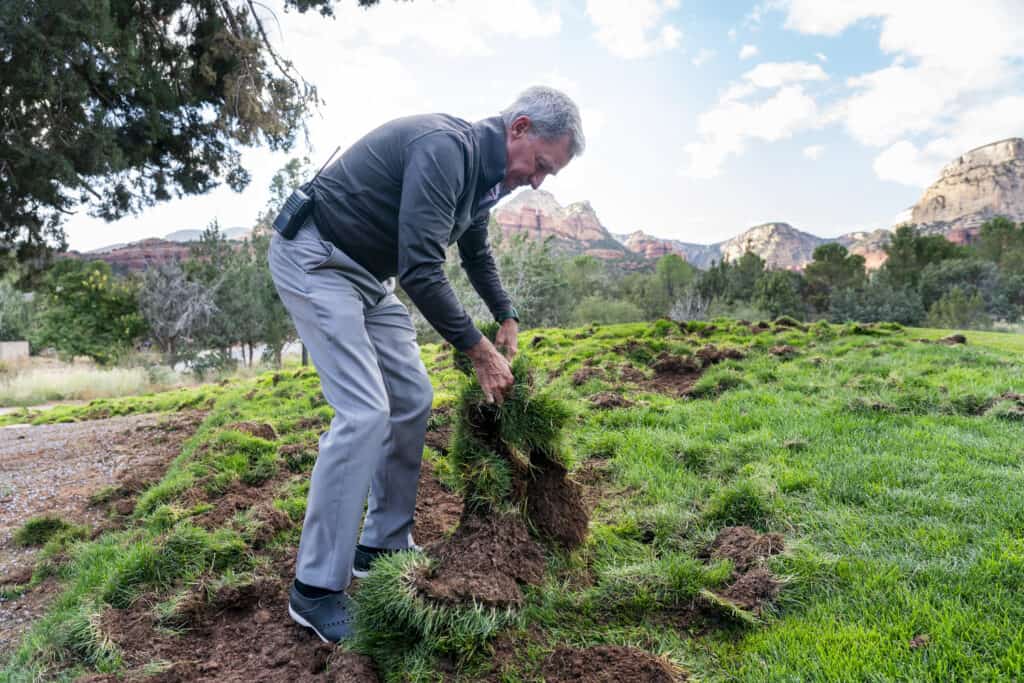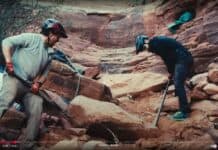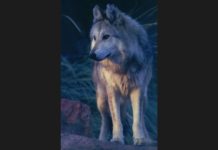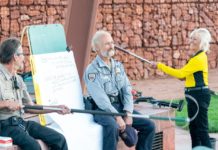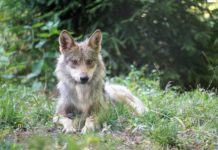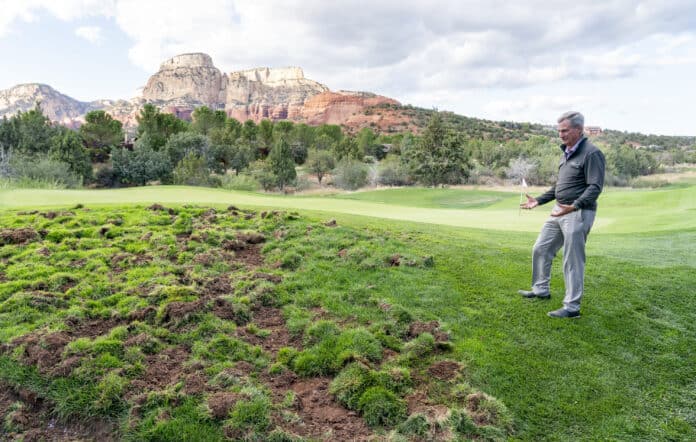
A video of javelina damage to the greens and fairways of the Seven Canyons Golf Club shot by Emily Casey, the club’s assistant superintendent, went viral over the weekend, gaining more than 30 million views on X, the app commonly called Twitter.
Dave Bisbee, the club’s general manager, estimated that the javelina are tearing up “several thousand square feet a night,” and that the labor required for repairs has cost the club “tens of thousands” of dollars since these incidents began occurring a month ago.
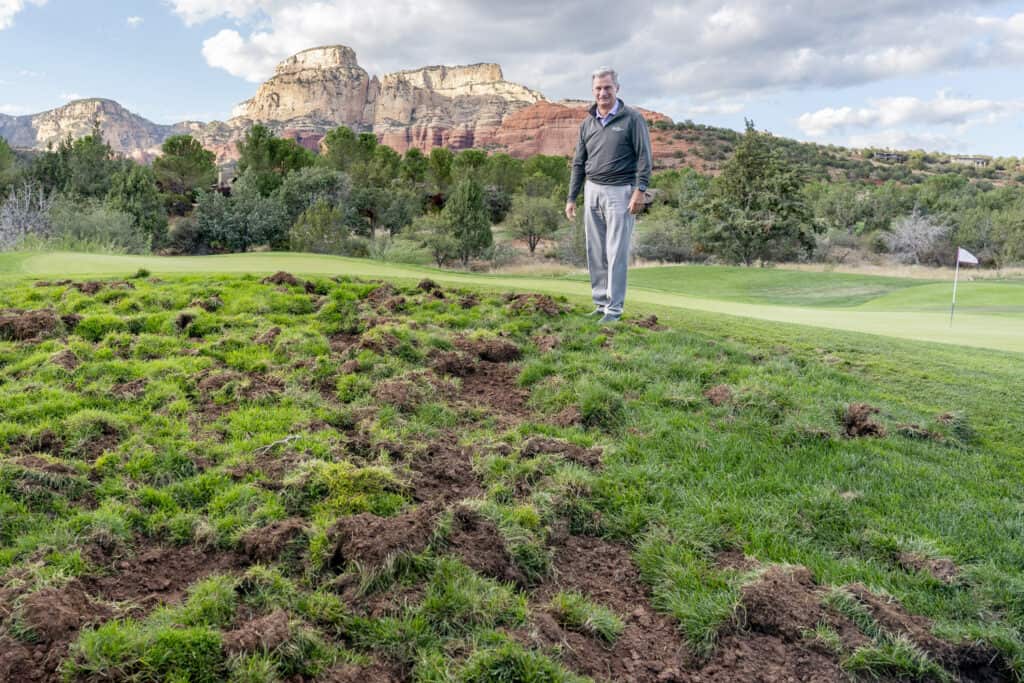
“We’ve had incursions like this happen between eight and 10 times over the 22 years that I’ve been here, and they’re always on these cycles of dry summer,” Bisbee said. He described this season’s damage as “moderately worse” than in previous years. “We are always looking for and trying to figure out ways to coexist with all of our wildlife while being good stewards.”
The club has been working with the Arizona Game & Fish Department to come up with a solution to the javelina problem. Some of the short-term solutions that have been discussed include relocating individual or multiple javelina.
Larry Phoenix, the Flagstaff regional supervisor for Game & Fish, said that a long-term solution might require the construction of additional fencing around the golf course.
“They live right there in the prime javelina habitat,” Phoenix said. “The golf course has all the … vegetation that javelinas like. [Javelina are] kind of homing in on that area like they do with the other golf courses, and neighborhoods around Sedona … We haven’t gotten to that point yet to decide what we’re going to do.”
As the vegetation in the surrounding desert starts dying off at this time of the year, Phoenix explained, javelina are drawn to locations like Seven Canyons.
“It’s coming into fall, they’re trying to find protein. So they’re rooting and tearing up turf to find worms,” Bisbee said. “We just ended up dealing with the aftermath of that.”
Bisbee said that he has also been working on asking residents of surrounding neighborhoods to avoid leaving food out for javelina, either intentionally or unintentionally.
“One thing that’s changed here over the last three years is significantly more people are living inside the gates now [because] homes have been completed,” Bisbee said. “People tend to want to see the wildlife and some will pass food out. So javelina get habituated to knowing where food has been thrown out … We’ve been stressing to the homeowners to not do anything to feed any of the wildlife to help curb their foraging around residences.”
Efforts to educate the homeowners are critical because most of the damage “tends to be closer to residences,” Bisbee said.
Club staff have also been driving around the course in the early evening hours to disrupt the javelina’s foraging patterns, which is Game & Fish’s most significant management recommendation, followed by reducing potential sources of food.
“We’ve tried a bit of cayenne pepper and some chili oils, those kinds of things,” Bisbee said. “Those are effective in small doses. But there’s not enough chili powder to go around.”
One attempt to dissuade the javelina even had the opposite result.
“We reached out to farmers and people around us, whether they’ve used anything [to repel javelina], and one of our local vendors told me you can get this granulated coyote urine and you sprinkle it around where their entry points are. So I ordered the coyote urine and when we went out and we sprinkled it around, it was like putting bacon bits on a salad. It was more intense [after that]. I don’t know if it made them mad, or maybe they just liked the seasoning, but that did not work.”
Holes nine, 10, 11, 12 and 16 have sustained most of the javelina activity, but the damage has had little effect on the golfing experience so far. Bisbee said that the patches of ripped turf haven’t limited golfers’ ability to get around the course and that the tee boxes haven’t been damaged.
While there have been no recent reports of people being injured by javelina, Phoenix did confirm that a dog was injured by a javelina over the weekend.
“We stress with everybody [that] we have a leash law inside the gates, and for people when they go to go outside with their dogs in the early evening hours, or especially after dark, that they have them on a leash, and they’d be very aware of their surroundings,” Bisbee said. “We’ve had some incidents with members and the javelina.”
“Lethal removal is always on the table, but it’s always our last go-to,” Phoenix said. “Nobody wants to have to do that [and] as long as we can deal with this problem … Even though we had a javelina get in a battle with a dog this weekend, that doesn’t raise the level to going in and lethally removing javelina … If they were proactively going after humans or those kinds of things, that would be a different story … At the moment, we’re not going down that path.”
Bisbee also mentioned that the club has been inundated with calls since the video was shared, and pointed out that the club uses its own well water, not public water, contrary to claims circulating online.
“We’re looking forward to the weather cooling off, because as soon as we get a freeze, the javelina damages stop, the worms go deep [underground] and javelinas quit looking,” Bisbee said.
Seven Canyons Golf Club now plans on posting a series of updates on its javelina-repelling efforts under the title “The Javelina Diaries” on Casey’s Twitter account at @emcaseyturf.
